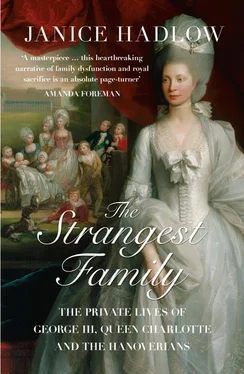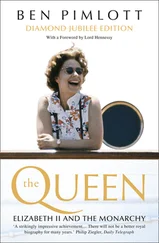Their marriage could not have been more different from that of George’s parents. From the very beginning, his young wife was the central focus of his life. In 1707, when she contracted smallpox, he nursed her throughout the illness, imperilling his own health as a consequence. Two years later, when Caroline gave birth to their eldest daughter, Anne, he wrote her a loving letter from which the warmth of his affection still radiates. ‘The peace of my life depends on knowing you in good health, and upon the conviction of your continued affection for me. I shall endeavour to attract it,’ he assured her, ‘by all imaginable passion and love, and I shall never omit any way of showing you that no one could be more wholly yours.’ 29Theirs was a partnership founded on passion – on George’s side at least. ‘It is certain,’ wrote Horace Walpole, ‘that the king always preferred the queen’s person to any other woman; nor ever described his idea of beauty, but that he drew a picture of his wife.’ 30For the rest of his life, Caroline exerted a physical attraction over him that was never truly extinguished, even when her youthful prettiness had been compromised by childbearing and her stately dignity edged into fat. Caroline was proud of her sexual hold over her husband; when she was over fifty, she showed Robert Walpole a letter George had written to her from Hanover which ‘spoke of his extreme impatience for their meeting; and in a style that would have made one believe him the rival of Hercules’ vigour and her of Venus’ beauty, her person being mentioned in the most exalted strains of rapture’. 31
Caroline responded to the blitzkrieg of George’s passion by surrendering herself entirely to it. She never looked at another man, and did everything she could to keep her mercurial husband satisfied. Her submission to him went far beyond the purely physical. From the day of her marriage until the day she died, over thirty years later, she rarely had a thought or performed an action that was not designed in some way to please him: ‘To him she sacrificed her time, for him she breathed every inclination; she looked, spake and breathed but for him, was a weathercock to every blast of his uncertain temper.’ 32Whether she did this out of love, or whether as a means of exercising through her husband the power and influence otherwise denied her as a woman, was the subject of constant speculation. Most thought that power played a large part in her calculations.
The complicated intensity of their relationship fascinated all those who witnessed it, and many contemporaries sought to explain and unpick its curious dynamic, the strange combination of attraction, manipulation and destructiveness that characterised their life together. For all the self-absorption of the couple at its centre, this was far from a conventionally happy marriage. Between George’s sexual thraldom and Caroline’s self-abnegating submission, some very dark currents seemed to flow; and many of those who found themselves caught in the eddies and undertows thus created were permanently damaged by the experience, not least the couple’s children, none of whom could be said to have emerged happily from the private world their parents created for themselves.
Perhaps theirs would have always been a marriage characterised by internal tension. It was, in many ways, an example of the attraction of opposites. They did not even look very well matched. Caroline was far taller than her husband, whose lack of height, slender build and love of overdressed magnificence inevitably attracted the epithet ‘dapper’. She was dignified and magisterial, though large in later life. One observer likened Caroline and her Maids of Honour, all dressed in pink, making their way through a crowded court, to a lobster pursued by shrimps. Caroline had little interest in the physical pursuits that George enjoyed, although she gamely accompanied him on his favourite stag hunts. Left to herself, Caroline preferred less punishing activities. She was a dedicated and accomplished gardener, later laying out and improving the parks at Richmond and Kew. George, who did not share her interest, refused to look at her ambitious plans, declaring that he ‘did not care how she flung away her own revenue’. He did not know that, having long ago exhausted her own resources in pursuing her gardening passions, she had persuaded Robert Walpole to subsidise her projects from Treasury funds.
While Caroline had no idea how to manage her own income, and was always in debt, George’s attitude to expenditure was very different: he was a compulsive hoarder of cash, regarded by most people who knew him as mean in a way unbefitting the grandeur of his position. Although his sympathies could be engaged by worthy causes – he contributed £2,000 to help establish London’s Foundling Hospital – George was always a more reluctant donor than his wife. It was all but impossible to prise money out of his hands; he even sought to wriggle out of annuities he had promised to pay his own daughters. Hervey thought it was hard to say whether passion for armies or for money predominated in his mind: ‘he could never have enough of either, and could seldom be persuaded to part with either, though he had more of both than he had any occasion to employ’. 33
Walpole once observed that George would rather have found a guinea in his pocket than have a work of literature dedicated to him. In contrast to the resolute philistinism of her husband, Caroline was completely at home in the world of books and ideas. She had ‘read a great deal’, noted Hervey with approval. ‘She understood good writing too, in English, the harmony of numbers in verse, the beauty of style in prose, and the force and propriety of terms much better than anyone who has only heard her speak English would ever have thought possible. She had a most incredible memory, and was learned both in ancient and modern history as the most learned men.’ 34Caroline was an intellectual woman who had been raised among other intellectual women. In the household in which she had grown up, the Electress Sophia and her daughter Sophia Charlotte had created a remarkable salon in which the greatest minds of their generation were invited to discuss the philosophical questions of the day. As a girl, Caroline had been an eager participant in the debates and arguments that dominated the days of these thoughtful princesses. The mathematician and philosopher Gottfried Leibniz acted as the resident in-house thinker of the Hanoverian women at Sophia Charlotte’s palace. He liked the young Caroline, although he sometimes found himself at the sharp end of her wit and thought her a little too fond of scoring points of argument at the expense of others. ‘I have a most bitter tongue,’ confessed Caroline in later years. There was little evidence here of the traditional pursuits of royal women – the fascination with scandal, needlework, dress and display that Caroline described dismissively as ‘paltry’. Instead, Sophia Charlotte turned her mind to bigger questions – ‘the why of why’, as Leibniz called it. No subject was off limits, and a scepticism towards traditional theology was much in evidence. (On her deathbed, Sophia Charlotte, who died at the age of only thirty-seven, refused the ministrations of a priest. ‘Do not pity me,’ she told those gathered around her, including a heartbroken Caroline; ‘I am going at last to satisfy my curiosity about the origin of things which even Leibniz could never explain to me, to understand space, infinity, being and nothingness.’ 35)
This was not a world in which Caroline’s husband would have felt at ease. Although Walpole believed George’s ‘understanding was not near so deficient as it was imagined’, intellectual discussion bored and unsettled him. 36When she became queen, Caroline sought to recreate in London the salon she had found so stimulating as a girl in Berlin; but the scorn of her husband cast a shadow over her efforts. Hervey noted with regret that she did not dare allow herself to indulge in the philosophical discussions she so enjoyed, ‘for fear of the king, who often rebuked her for dabbling in all that learned nonsense (as he called it)’. 37Nor did he share her artistic interests. Once, when George was away in Hanover, Caroline and Hervey took ‘several very bad pictures out of the great Drawing Room at Kensington, and put very good ones in their place’. When George returned he was furious, and insisted that Hervey have ‘every new picture taken away and all the old ones replaced’. When asked if any of the newly transplanted paintings might be allowed to remain, the king was adamant all must go, especially ‘the picture with the dirty frame over the door, and the three nasty little children’. Thus dismissing Van Dyck’s masterly portrait of the children of Charles I, he told the disdainful Hervey that he especially wanted the painting of his ‘gigantic fat Venus’ returned. ‘I am not as nice as your lordship. I like my fat Venus much better than anything you have given me instead of her.’ 38
Читать дальше












